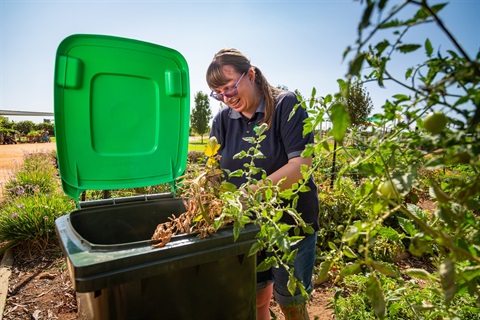
The first 12 months of Mildura Rural City Council's three-bin service has been a resounding success, slashing waste to landfill, creating additional bin space for organics and making major progress towards Council's aim of zero net emissions by 2050.
Introduced in July 2020, the three-bin service has halved the amount of waste to landfill - from 12,300 tonnes in 2019/2020 to just 6,012 tonnes in 2020/21.
This is despite an overall increase in the amount of waste generated in our region over the past year and represents a diversion rate of 74%, up from 31%.
Councillor for Environment and Sustainability Jodi Reynolds congratulated the community for embracing change.
"We realise this has been a big adjustment for some residents, but it's been amazing to see how readily and enthusiastically the majority of our community have taken to the new service," Cr Reynolds said.
"To see our diversion rates shoot from 31% to 74% in the space of just 12 months tells us the new service works well, and is being used well by most people in our municipality."
As part of the 12-month review of the service, an independent audit of how each of the three bins were being used was conducted in May this year.
The results revealed:
- Almost 60% of the rubbish found in red bins should have been disposed of in the yellow or green bins, the majority of which was food waste. This means less than half of the capacity of red bins is being utilised properly in some cases.
- The newly introduced green bins are being used well, with a contamination rate less than 7%, which is a positive result given half of all waste generated in our municipality is organic waste.
- Recycling bins are also being used well, with a contamination rate less than 10%.
Cr Reynolds said the results of the audit show that while many have adapted well to the new three-bin service, improvements can be made in how red landfill bins are used.
"We're aware there has been attention around the fortnightly collection of red landfill bins over the past 12 months, but our independent waste audit shows us that some residents could more than double the space available in their red bins if they separated their waste more in their homes," she said.
"Almost a quarter of the waste found in red bins that could have gone in residents' new 240-litre green bin was food scraps, which tells us we can certainly improve these contamination rates with a few simple changes in our kitchens and homes.
"I would encourage anyone who wants to know more about how to manage their red bin, or wants some tips on how to make best use of it, to contact our Waste Management team who are there to help."
While reducing waste to landfill, cutting emissions and providing an additional bin for residents' organic and garden waste are among the primary benefits of the new three-bin service, there have been several other important gains.
The additional 240-litre bin for residents' organic and garden waste has resulted in less illegal dumping, which has plummeted by almost 30% over the past 12 months.
The new service has also saved Council, and ultimately ratepayers, more than $420,000 in additional Victorian Government waste charges over the past year.
"We know Victorian Government waste levies, which are charged based on the amount of waste to landfill, will be going up every year, and the only way to minimise these additional costs is to cut the amount of waste we're sending to landfill," Cr Reynolds said.
"Based on current forecasts, we expect to save our municipality more than $5 million in potential waste charges under our current three-bin service over the next decade, which is huge."
Council will continue to work with the community to help with the transition to the three-bin service, including education and awareness campaigns.






